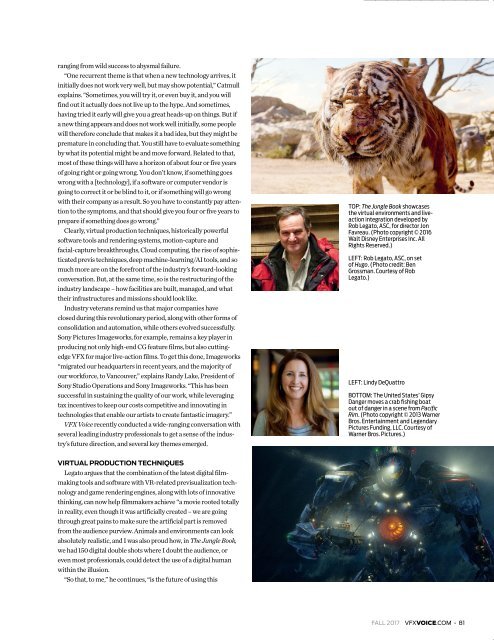You also want an ePaper? Increase the reach of your titles
YUMPU automatically turns print PDFs into web optimized ePapers that Google loves.
anging from wild success to abysmal failure.<br />
“One recurrent theme is that when a new technology arrives, it<br />
initially does not work very well, but may show potential,” Catmull<br />
explains. “Sometimes, you will try it, or even buy it, and you will<br />
find out it actually does not live up to the hype. And sometimes,<br />
having tried it early will give you a great heads-up on things. But if<br />
a new thing appears and does not work well initially, some people<br />
will therefore conclude that makes it a bad idea, but they might be<br />
premature in concluding that. You still have to evaluate something<br />
by what its potential might be and move forward. Related to that,<br />
most of these things will have a horizon of about four or five years<br />
of going right or going wrong. You don’t know, if something goes<br />
wrong with a [technology], if a software or computer vendor is<br />
going to correct it or be blind to it, or if something will go wrong<br />
with their company as a result. So you have to constantly pay attention<br />
to the symptoms, and that should give you four or five years to<br />
prepare if something does go wrong.”<br />
Clearly, virtual production techniques, historically powerful<br />
software tools and rendering systems, motion-capture and<br />
facial-capture breakthroughs, Cloud computing, the rise of sophisticated<br />
previs techniques, deep machine-learning/AI tools, and so<br />
much more are on the forefront of the industry’s forward-looking<br />
conversation. But, at the same time, so is the restructuring of the<br />
industry landscape – how facilities are built, managed, and what<br />
their infrastructures and missions should look like.<br />
Industry veterans remind us that major companies have<br />
closed during this revolutionary period, along with other forms of<br />
consolidation and automation, while others evolved successfully.<br />
Sony Pictures Imageworks, for example, remains a key player in<br />
producing not only high-end CG feature films, but also cuttingedge<br />
<strong>VFX</strong> for major live-action films. To get this done, Imageworks<br />
“migrated our headquarters in recent years, and the majority of<br />
our workforce, to Vancouver,” explains Randy Lake, President of<br />
Sony Studio Operations and Sony Imageworks. “This has been<br />
successful in sustaining the quality of our work, while leveraging<br />
tax incentives to keep our costs competitive and innovating in<br />
technologies that enable our artists to create fantastic imagery.”<br />
<strong>VFX</strong> <strong>Voice</strong> recently conducted a wide-ranging conversation with<br />
several leading industry professionals to get a sense of the industry’s<br />
future direction, and several key themes emerged.<br />
TOP: The Jungle Book showcases<br />
the virtual environments and liveaction<br />
integration developed by<br />
Rob Legato, ASC, for director Jon<br />
Favreau. (Photo copyright © 2016<br />
Walt Disney Enterprises Inc. All<br />
Rights Reserved.)<br />
LEFT: Rob Legato, ASC, on set<br />
of Hugo. (Photo credit: Ben<br />
Grossman. Courtesy of Rob<br />
Legato.)<br />
LEFT: Lindy DeQuattro<br />
BOTTOM: The United States’ Gipsy<br />
Danger moves a crab fishing boat<br />
out of danger in a scene from Pacific<br />
Rim. (Photo copyright © 2013 Warner<br />
Bros. Entertainment and Legendary<br />
Pictures Funding, LLC. Courtesy of<br />
Warner Bros. Pictures.)<br />
VIRTUAL PRODUCTION TECHNIQUES<br />
Legato argues that the combination of the latest digital filmmaking<br />
tools and software with VR-related previsualization technology<br />
and game rendering engines, along with lots of innovative<br />
thinking, can now help filmmakers achieve “a movie rooted totally<br />
in reality, even though it was artificially created – we are going<br />
through great pains to make sure the artificial part is removed<br />
from the audience purview. Animals and environments can look<br />
absolutely realistic, and I was also proud how, in The Jungle Book,<br />
we had 150 digital double shots where I doubt the audience, or<br />
even most professionals, could detect the use of a digital human<br />
within the illusion.<br />
“So that, to me,” he continues, “is the future of using this<br />
FALL <strong>2017</strong> <strong>VFX</strong>VOICE.COM • 81




